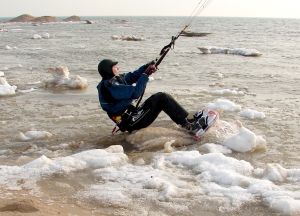Cold Water Safety
Kiteboarding FAQs: Kiteboarding Safety in Cold Water
Riding the Great Lakes in Spring and Fall: Cold Water Awareness
Behold the warm spring air. Beware the cold water. Riders literally start hitting the water as soon as the ice is gone on Lake Michigan so it is a good time to remember, or learn, some basic cold water tips. Situational awareness is especially important in the spring when you may find yourself encouraged by the warm air and sight of other riders on the water. Ask yourself three questions. What is my level of conditioning? What is my ability level? Do I have the right gear? The first few rides of the season can really take a toll on your body; you will tire quicker, and may need a bit to get your muscle memory back. Additionally, if you are learning you are going to be down in the water a lot more. Lastly, be sure you have done all you can to make sure your gear is in good working order and condition. When considering gear, your suit is critical. If you are new to the sport, don't get caught making the assumption that a $99 wetsuit is going to do the job of a steamer or dry suit, which may look like a plain wetsuit. A steamer usually has a smooth, non-wicking skin, taped & glued seams, seals that let very little water in, and is constructed of a thicker neoprene. If the combined air and water temp is below 110 degrees F, booties, gloves, and a hood are wise. If the combined temp is below 80, well, that is where I draw the line. Everyone has to come up with their own guidelines. The important part is to do your research, talk to others, and have a plan before you show up with the adrenaline pumping.
When considering gear, your suit is critical. If you are new to the sport, don't get caught making the assumption that a $99 wetsuit is going to do the job of a steamer or dry suit, which may look like a plain wetsuit. A steamer usually has a smooth, non-wicking skin, taped & glued seams, seals that let very little water in, and is constructed of a thicker neoprene. If the combined air and water temp is below 110 degrees F, booties, gloves, and a hood are wise. If the combined temp is below 80, well, that is where I draw the line. Everyone has to come up with their own guidelines. The important part is to do your research, talk to others, and have a plan before you show up with the adrenaline pumping.
Regarding what actually can happen, let's look at a scenario where you are riding hard and making enough of your own heat and adrenaline to be comfortable, and then you drop the kite. 45 degree water feels like a kick in the face. Your adrenaline buzz goes away quickly and you need to get up quick. Stay in too long and your extremities start to feel like stumps, which makes it even harder to get going. It is a vicious cycle. Furthermore, when your temp really starts to drop, you start to feel like you have had a few cocktails, further diminishing your decision making and coordination.
Symptoms usually develop slowly. Someone with hypothermia typically experiences gradual loss of mental acuity and physical ability. The key symptom of hypothermia is a body temperature that drops to less than 94 F. Signs include:
- Shivering
- Slurred speech
- Abnormally slow rate of breathing
- Cold, pale skin
- Loss of coordination
- Fatigue, lethargy or apathy
- Irritability, combativeness
I have seen very competent riders with the correct gear towed in like a log due to hypothermia. We have also lost a waterman up at Little Point Sauble who was riding alone in cold water. So here are the tips:
1. Know your level of condition, ability, and gear.
2. DON'T RIDE ALONE!
3. Know how to recognize the warning signs of hypothermia.
4. Know the air and water temp before you head out.
5. Don't go out further than you are willing and able to swim.
Answer the following question, and have a great season!
I consider myself to be __________.
A. Intelligent, I learn from my own mistakes.
B. Wise, I learn from the mistakes of others.
C. Neither A. nor B. I could end up a candidate for the "Darwin Award".
By Brad Knoth, Team Rider for Cabrinha
Hypothermia Prevention
 Hypothermia is a risk for anyone who enjoys water activities like kitesurfing, fishing, swimming, or skiing. It can occur quickly and it can be fatal. Brad Knoth's article lists some very important questions that local water sports enthusiasts should ask themselves before they venture in the water.
Hypothermia is a risk for anyone who enjoys water activities like kitesurfing, fishing, swimming, or skiing. It can occur quickly and it can be fatal. Brad Knoth's article lists some very important questions that local water sports enthusiasts should ask themselves before they venture in the water.
Hypothermia occurs when the body's core temperature falls below its normal level of 98.6°F to 95°F or cooler. It is the opposite of fever, when the body's temperature is above normal.
Hypothermia is dangerous because it affects the body's core - the brain, heart, lungs, and other vital organs. Even a mild case of hypothermia affects your physical and mental abilities, and increases the risk of accidents. Severe hypothermia causes loss of consciousness and may result in death.
Cold water is especially dangerous because loss of body heat occurs 25 times faster in cold water than in cold air. The current Lake Michigan water temperature (March 27, 2004) is less than 40 degrees. How quickly you become hypothermic depends on many factors, including your personality and behavior, environmental factors, how you are dressed, and your physical condition.
Everyone reacts differently to the cold, even under the same conditions. Generally, children lose body heat more quickly than adults. Thin people lose body heat faster than overweight people. The expected survival times in the table are guidelines for the average adult, showing the rapid onset of hypothermia as water temperatures drop.
Cold Water Temperatures Decrease Time Before Exhaustion and Decrease Survival Time
| Water Temperature (ºF) | Expected Time Before Exhaustion or Unconsciousness | Expected Time of Survival |
| 32.5 | Under 15 minutes | 45 minutes |
| 32.5-40 | 15-30 minutes | 30-90 minutes |
| 40-50 | 30-60 minutes | 1-3 hours |
| 50-60 | 1-2 hours | 1-6 hours |
| 60-70 | 2-7 hours | 2-40 hours |
| 70-80 | 3-12 hours | 3 hours to Indefinite |
| Over 80 | Indefinite | Indefinite |
THE RISK
Lake Michigan's spring water temperature ranges from 30 degrees to 50 degrees. Water this cold always presents the danger of hypothermia. Hypothermia can creep up on you when you are participating in an exhilarating sport like kite surfing.
NEOPRENE OPTIONS IN THE WATER
Most local sailors, kiters, and water skiers use neoprene drysuits or 'steamer' wetsuits that are 5 to 3 millimeters thick. A drysuit will keep water away from your skin with the use of a drysuit zipper that runs along the shoulders. "Steamer" wetsuits use water proof seams throughout the suit but a zipper that allows a small amount of water to enter the suit. Neoprene booties and gloves are required to keep your hands and feet warm. A layer of poly propylene underwear underneath your suit can retain your body heat against the cold water temperature. A hood is recommended to keep your head warm. A PFD or impact vest can also help retain body heat.
SYMPTOMS OF HYPOTHERMIA
When you first fall into cold water you gasp, your skin begins to cool, and your body constricts surface blood vessels to conserve heat for your vital organs. Blood pressure and heart rate increase. Muscles tense and shiver; this produces more body heat, but results in a loss of dexterity and motor control. As your body's core temperature drops further, blood pressure, pulse, and respiration rates all decrease. As conditions worsen, your mental attitude and level of consciousness change. Resisting help and acting irrational or confused are common indicators of hypothermia. As your core temperature drops dangerously low (from 90°F to 82°F), you become semiconscious, then unconscious. Stress, shock, and low core temperatures may cause cardiac and respiratory failure.
FIRST AID
Minimize the victim's physical exertion when removing her or him from cold water. Rescuers may have to enter the water to get the victim. Once out of the water, gently remove wet clothing and cover the person with dry clothing or blankets. Protect the victim from wind, especially around the head and neck. Get her or him into a warm environment promptly and avoid re-exposure to the cold.
Choose first aid methods based on the severity of hypothermia symptoms and the field conditions. Decide if artificial respiration or cardio-pulmonary resuscitation (CPR) is needed, assess the severity of the hypothermia, and re-warm the victim.
By Skip Schott
Return to the Kiteboarding Knowledge Center
